| Epuraea guttata | |
|---|---|
 | |
| Scientific classification | |
| Kingdom: | |
| Phylum: | |
| Class: | |
| Order: | |
| Family: | |
| Genus: | |
| Species: | E. guttata |
| Binomial name | |
| Epuraea guttata (Olivier, 1790) | |
Epuraea guttata is a species of sap beetle of the subfamily Carpophilinae.
| Epuraea guttata | |
|---|---|
 | |
| Scientific classification | |
| Kingdom: | |
| Phylum: | |
| Class: | |
| Order: | |
| Family: | |
| Genus: | |
| Species: | E. guttata |
| Binomial name | |
| Epuraea guttata (Olivier, 1790) | |
Epuraea guttata is a species of sap beetle of the subfamily Carpophilinae.
Body length of an adult is 2.6–4.4 millimetres (0.10–0.17 in). [1] The pronotum, mesonotum, and metanotum are strongly shiny. The head and legs have a moderate shine, as do the elytra. The abdomen is matte. [2]
The body length of pupae ranges from 3.1–3.65 millimetres (0.122–0.144 in), and their width between 1.45–1.7 millimetres (0.057–0.067 in). [2] Pupae range in color from whitish to cream, except for the longitudinal tubercles, which are light brown in color.
[ citation needed ]
The beetles live in groves that include the English oak. They can be found under the bark, feeding on the sap of deciduous trees. They are occasionally found in association with the larvae of stem-boring moths of genus Cossus .
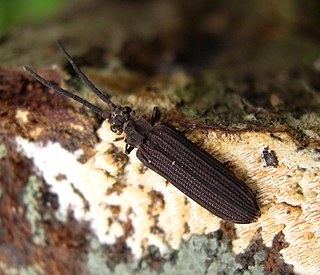
The Cupedidae are a small family of beetles, notable for the square pattern of "windows" on their elytra, which give the family their common name of reticulated beetles.

The scarce swallowtail is a butterfly belonging to the family Papilionidae. It is also called the sail swallowtail or pear-tree swallowtail.

Dynastes tityus, the eastern Hercules beetle, is a species of rhinoceros beetle that lives in the Eastern United States. The adult's elytra are green, gray or tan, with black markings, and the whole animal, including the male's horns, may reach 60 mm (2.4 in) in length. The grubs feed on decaying wood from various trees.
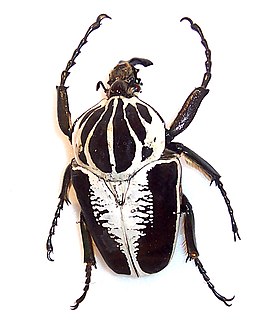
The Goliath beetles are any of the five species in the genus Goliathus. Goliath beetles are among the largest insects on Earth, if measured in terms of size, bulk and weight. They are members of subfamily Cetoniinae, within the family Scarabaeidae. Goliath beetles can be found in many of Africa's tropical forests, where they feed primarily on tree sap and fruit. Little appears to be known of the larval cycle in the wild, but in captivity, Goliathus beetles have been successfully reared from egg to adult using protein-rich foods such as commercial cat and dog food. Goliath beetles measure from 60–110 millimetres (2.4–4.3 in) for males and 50–80 millimetres (2.0–3.1 in) for females, as adults, and can reach weights of up to 80–100 grams (2.8–3.5 oz) in the larval stage, though the adults are only about half this weight. The females range from a dark brown to silky white, but the males are normally brown/white/black or black/white.

Goliathus orientalis is a species of beetles belonging to the family Scarabaeidae.
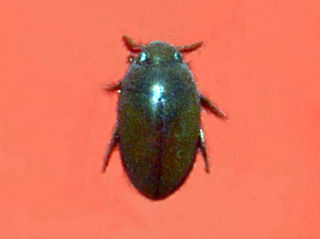
Noterus clavicornis is a species of beetle belonging to the family Noteridae.
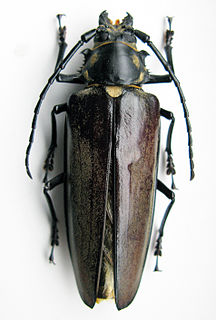
Callipogon relictus is a species of longhorn beetle which is mostly found in Korea, but also in China and southern part of Russian Far East. It inhabits mixed and deciduous forests. The population of Callipogon relictus is decreasing due to deforestation and uncontrolled collection, and therefore the species are listed in the Russian Red Book.

Glischrochilus is a genus of sap-feeding and predatory beetles under the family Nitidulidae, subfamily Cryptarchinae. Most members of this genus are commonly known as picnic beetles or beer bugs.
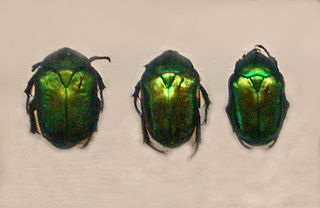
Protaetia speciosa is a beetle of the family Scarabaeidae and subfamily Cetoniinae.
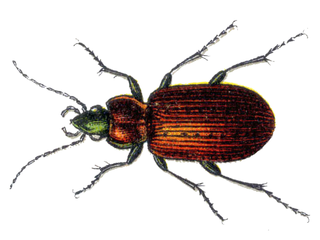
Agonum impressum is a species of ground beetles in the subfamily Platyninae.

Ipidia binotata is a species of beetles from sap beetle family, that can be found in Russia, Sweden, and Spain.
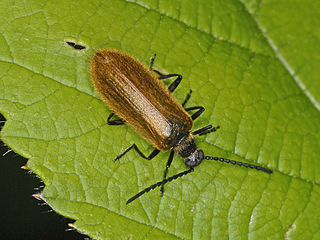
Lagria hirta is a species of beetles in the family Tenebrionidae.

Arostropsis is an extinct genus of broad-nosed weevil in the beetle family Curculionidae known from an Upper Eocene fossil found in Europe. The genus contains a single described species, Arostropsis groehni.
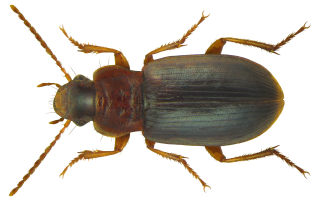
Ophonus rufibarbis is a species of ground beetle that can be found everywhere in Europe and the Near East.

Zabrus tenebrioides is a species of black coloured ground beetle in the Pterostichinae subfamily that can be found everywhere in Europe and the Near East.
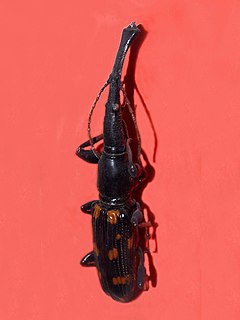
Eutrachelus temmincki is a species of straight-snouted weevils belonging to the family Brentidae.

Cyrtotrachelus dux, the Bamboo beetle or Long Armed Snout Beetle, is a species of beetles belonging to the family Curculionidae.
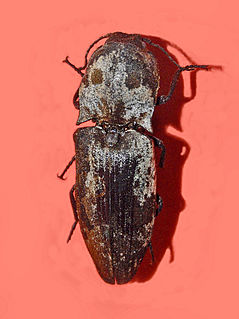
Calais parreysii is a species of click beetle belonging to the family Elateridae subfamily Agrypninae.

Conognatha pretiosissima is a species of beetles in the family Buprestidae.

Burmocoelus is an extinct genus of Archostematan beetle belonging to the family Ommatidae. It is known from two species, Burmocoleus zhiyuani, which was initially assigned to the genus Brochocoleus this was placed into the new genus Burmocoleus by Kirejtshuk, 2020, who also described a new species, Burmocoleus prisnyi. Both species are known from the Cenomanian aged Burmese amber from Myanmar. Similar to Stegocoleus, Brochocoleus and Jarzembowskiops it has flat, wide elytral edges, but can be distinguished from these genera in several characters, and is more similar to other ommatids in the characters of the prothorax.
| This Nitidulidae-related article is a stub. You can help Wikipedia by expanding it. |